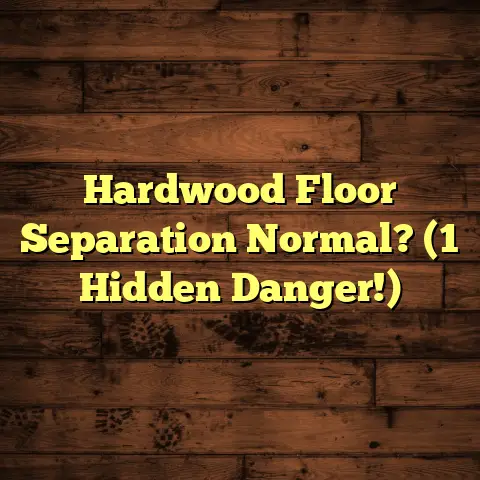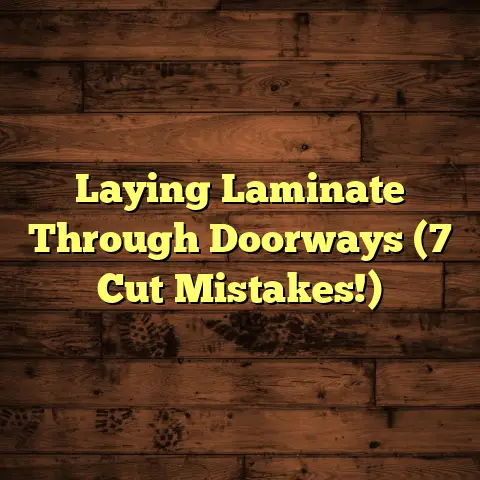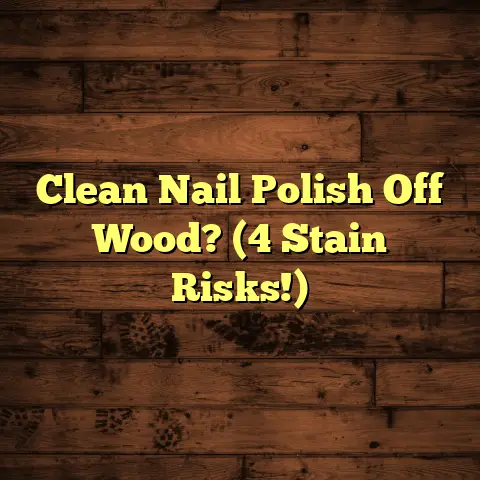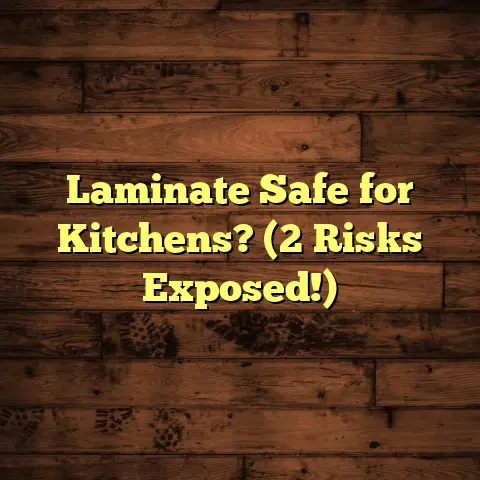How To Dispose Of Vinyl Flooring? (Avoid This Fine!)
Ever ripped up old vinyl flooring, feeling accomplished, only to wonder, “Now what?”
Believe me, I’ve been there.
I even made a mistake once, almost costing me a hefty fine.
That’s why I’m writing this – to save you from the same headache!
Tossing that old vinyl in the regular trash might seem like the easiest option, but trust me, it’s a shortcut to trouble.
Many areas have strict environmental regulations, and improperly disposing of vinyl flooring can lead to some serious financial penalties.
I’m talking hundreds, even thousands, of dollars!
Let’s dive into how to dispose of vinyl flooring the right way, save some green (the money kind!), and keep our planet a little greener too.
Section 1: Understanding Vinyl Flooring
What is Vinyl Flooring?
So, what exactly is vinyl flooring?
Well, it’s a synthetic flooring option made primarily from polyvinyl chloride (PVC) and other plasticizers.
Think of it as a multi-layered material designed for durability and water resistance.
You’ll typically find it in a few common forms:
-
Vinyl Tiles: Individual squares, often peel-and-stick or glue-down.
-
Vinyl Sheets: Large rolls that cover an entire room, minimizing seams.
-
Vinyl Planks: Designed to mimic the look of hardwood, often with click-lock installation.
Vinyl flooring’s popularity stems from its affordability, resilience, and wide range of styles.
It’s a go-to choice for kitchens, bathrooms, and basements because it can handle moisture and heavy foot traffic like a champ.
Environmental Impact of Vinyl Flooring
Now, let’s talk about the not-so-pretty side: the environmental impact.
PVC, the main ingredient in vinyl, is derived from petroleum, a non-renewable resource.
The production process can release harmful emissions, and the disposal of vinyl flooring presents its own set of challenges.
According to a report by the Healthy Building Network, PVC is one of the most environmentally damaging plastics.
“PVC production releases dioxins, potent carcinogens, into the environment.”
And, unfortunately, a large portion of vinyl flooring ends up in landfills.
While some types of vinyl flooring are more eco-friendly than others (think those made with recycled content or bio-based plasticizers), it’s essential to be aware of the overall impact.
Section 2: Legal Regulations and Fines
Overview of Regulations
Okay, this is where things get serious.
Many local, state, and federal regulations govern the disposal of construction and demolition (C&D) debris, which includes vinyl flooring.
These regulations are in place to minimize environmental pollution and conserve landfill space.
For example, some areas prohibit the disposal of certain types of plastics in landfills, requiring them to be recycled or disposed of in a specific manner.
Hazardous waste regulations might also come into play, especially if you’re dealing with older vinyl flooring that could contain asbestos (more on that later).
It’s crucial to check with your local waste management authority or environmental protection agency to understand the specific rules in your area.
A quick search for “[Your City/County] waste disposal regulations” should point you in the right direction.
Case Studies of Fines
Let me tell you, ignorance is not bliss when it comes to waste disposal.
I’ve heard stories of homeowners getting hit with fines for simply tossing old vinyl flooring in their regular trash bins.
Contractors, too, aren’t exempt.
In fact, they’re often held to a higher standard, as they’re expected to be knowledgeable about proper disposal methods.
I remember a case a few years back where a contractor in my area was fined $5,000 for illegally dumping construction debris, including vinyl flooring, in a vacant lot.
The financial implications of non-compliance can be significant, not to mention the legal headaches and potential damage to your reputation.
Section 3: Preparing for Disposal
Assessing Your Vinyl Flooring
Before you start ripping up that old flooring, take a moment to assess what you’re dealing with.
First, identify the type of vinyl flooring you have: tiles, sheets, or planks.
This will influence the removal process.
Next, evaluate its condition.
Is it heavily damaged, moldy, or potentially contaminated with hazardous materials?
This is crucial.
Older vinyl flooring, especially that installed before the 1980s, could contain asbestos.
Asbestos is a known carcinogen, and disturbing it can release harmful fibers into the air.
If you suspect your flooring contains asbestos, do not attempt to remove it yourself.
Contact a qualified asbestos abatement professional for testing and removal.
Gathering Necessary Tools and Materials
Alright, assuming your flooring is asbestos-free (or has been professionally abated), let’s gather the tools you’ll need for removal and disposal:
-
Gloves: Protect your hands from sharp edges and adhesives.
-
Mask: Especially important if you’re dealing with dusty or moldy flooring.
-
Utility Knife: For scoring and cutting the vinyl.
-
Pry Bar or Scraper: To lift the flooring from the subfloor.
-
Heavy-Duty Disposal Bags or Containers: For containing the removed flooring.
-
Broom and Dustpan: To clean up debris.
-
Safety Glasses: Protect your eyes from flying debris.
Section 4: Safe Removal of Vinyl Flooring
Step-by-Step Guide to Removal
Okay, let’s get down to business.
Here’s a step-by-step guide to safely removing vinyl flooring:
Prepare the Area: Clear the room of all furniture and belongings.
Cover any surfaces you want to protect with drop cloths.Score the Flooring: Use a utility knife to score the vinyl into manageable sections.
This will make it easier to remove.Loosen the Edges: Use a pry bar or scraper to carefully lift the edges of the flooring.
Work slowly and methodically to avoid damaging the subfloor.Remove the Flooring: Once the edges are loose, continue lifting and peeling the flooring away from the subfloor.
You may need to use the utility knife to cut through any stubborn areas.Clean the Subfloor: Once the flooring is removed, clean the subfloor thoroughly to remove any adhesive residue or debris.
A floor scraper and a good floor cleaner will come in handy here.
Tips for Minimizing Damage:
-
Work slowly and carefully. Rushing the process can lead to damage to the subfloor.
Use the right tools.
A sharp utility knife and a sturdy pry bar are essential.-
If you encounter stubborn adhesive, try using a heat gun to soften it.
Handling Hazardous Materials
As I mentioned earlier, if you suspect your flooring contains asbestos, do not attempt to remove it yourself.
Contact a qualified asbestos abatement professional.
They will have the necessary training, equipment, and expertise to safely remove and dispose of the asbestos-containing material.
The process typically involves:
-
Containment: Sealing off the work area to prevent the spread of asbestos fibers.
-
Wetting: Dampening the asbestos-containing material to minimize the release of fibers.
-
Removal: Carefully removing the material using specialized tools and equipment.
-
Disposal: Properly disposing of the asbestos-containing material at a designated hazardous waste facility.
Section 5: Disposal Options
Recycling Vinyl Flooring
Believe it or not, recycling vinyl flooring is possible!
While it’s not as widely available as recycling paper or plastic, there are programs and facilities that accept vinyl flooring for recycling.
The benefits of recycling are clear: it reduces landfill waste, conserves natural resources, and lowers the environmental impact of vinyl flooring.
To find recycling options in your area, try searching online for “vinyl flooring recycling [Your City/County]”.
You can also contact your local waste management authority or building supply stores to inquire about recycling programs.
Safe Disposal in Landfills
If recycling isn’t an option, you’ll need to dispose of your vinyl flooring in a landfill.
But before you load up your truck, there are a few things you need to know.
First, check with your local landfill to see if they have any specific requirements for accepting vinyl flooring.
Some landfills may require you to wrap the flooring in plastic or place it in designated containers.
They may also have restrictions on the amount of C&D debris they accept from residential customers.
To avoid fines, make sure you follow all of the landfill’s rules and regulations.
Professional Disposal Services
If all of this sounds like too much hassle, you can always hire a professional disposal service.
These companies specialize in removing and disposing of C&D debris, including vinyl flooring.
When selecting a disposal service, be sure to ask about their disposal methods and ensure they comply with all local regulations.
Get a quote from several companies before making a decision.
The cost of professional disposal will vary depending on the amount of flooring you need to dispose of and the distance to the disposal facility.
Section 6: Final Thoughts and Recommendations
Importance of Compliance
Let me hammer this home (pun intended!): following local regulations for vinyl flooring disposal is essential.
Not only will it help you avoid fines, but it will also protect the environment and contribute to a more sustainable future.
Take the time to research the regulations in your area and choose the disposal option that best suits your needs.
Your wallet – and the planet – will thank you!
Future Considerations
The world of flooring is constantly evolving, with new materials and technologies emerging all the time.
Sustainable flooring options, such as bamboo, cork, and recycled materials, are becoming increasingly popular.
As these options gain traction, we may see changes in disposal practices as well.
Keep an eye on industry trends and stay informed about the latest developments in flooring disposal.
Conclusion: Summarizing Key Points
Alright, let’s wrap things up.
We’ve covered a lot of ground in this article, from understanding the environmental impact of vinyl flooring to navigating the legal regulations surrounding its disposal.
Remember these key points:
-
Improper disposal of vinyl flooring can lead to hefty fines.
-
Always check with your local waste management authority to understand the regulations in your area.
-
Assess your flooring for hazardous materials, such as asbestos, before attempting to remove it.
-
Consider recycling your vinyl flooring if possible.
-
If landfill disposal is your only option, follow all of the landfill’s rules and regulations.
-
Don’t be afraid to hire a professional disposal service if you need help.
By following these guidelines, you can dispose of your vinyl flooring safely, responsibly, and legally.
Now go forth and conquer that flooring project, knowing you’re doing your part to protect the environment!





